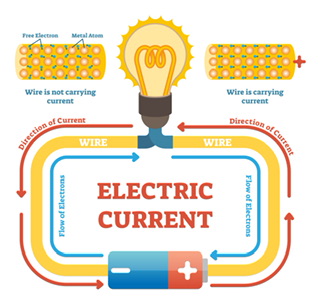We'll be back in a bit !
The system is currently undergoing a routine upgrade to ensure you get the best learning experience. The maintenance is expected to continue till 8:00 pm. Please check back later.
Thank you for your understanding!

Inside a material are millions of atoms. These atoms have several electrons revolving around the nucleus and none of these electrons are at rest. Under certain conditions, it is possible to get these electrons to flow across the material in a guided manner. This flow of charges is known as electric current. The branch of physics that deals with the study of current and electricity began with the invention of batteries by Alessandro Voldo.
Today, the world is heavily dependent on electricity as a form of energy and our lives would become impossible without it. This article discusses current and electricity from a physicist’s perspective.
Current is the flow of charges across a given conducting path and its direction is conventionally taken to be opposite to the direction of movement of electrons. This means that current flows from a region of lower voltage to a region of higher voltage. In practice, this voltage difference is generally created using a battery, which gives rise to the movement of electrons inside the material. Electric current is defined as the amount of charge flowing through a given cross-section in unit time. Mathematically,
Current is not directly dependent on the size of the cross-section through which charges are flowing. Rather, it is only the amount of charge and the time taken that makes a difference. In general, since the flow of charges isn’t a constant value,
And the instantaneous value of current may be found by taking the limiting case of the above equation.
The SI unit of measuring current is the Ampere, which is defined as the flow of 1 Coulomb charge in 1 second.
The direction of electric current is represented by arrows in the circuit. When a battery is attached to a circuit, electrons flow from the negative to the positive terminal. And conventionally, the direction of current is taken as opposite to the direction of electron flow, i.e., from the positive to the negative terminal.
These are two universally valid laws given by the physicist Kirchhoff, and they can be applied in any circuit regardless of its nature and complexity.
According to this law, the algebraic sum of currents at a junction is zero. This means that the amount of current entering a junction equals the amount of current leaving it. Sign convention dictates that current flowing into the junction is taken as positive while current leaving the junction is taken to be negative.
Kirchoff’s current law
Description: Currents entering and leaving a junction sum up to zero.
In the figure above,
This law states that in a closed loop, the sum of the electromotive forces and the product of current and resistance across elements equals zero. This law is based on the conservation of energy.
1. Find the value of I in the following circuit.
By applying Kirchoff’s first law at the junction P, we get the following relation:
Notice that currents leaving the circuit have been taken to be negative.
2. Find a relation between the various currents shown in the following circuit:
Once again, we can apply Kirchhoff's voltage law to the loops. Across EACE,
Similarly, along the loop ABCA, we get
Current is defined as the flow of charges across a conducting path and it is measured in Amperes. 1 Ampere is the flow of 1 Coulomb of charge in 1 second. Conventionally, the direction of current is taken to be opposite the direction of electron flow since in practical circuits, it is the movement of electrons that gives rise to current.
In a circuit, the values of currents, electromotive forces, and resistances can be related together via Kirchoff’s laws, which are a set of two universally valid rules regardless of the nature and complexity of a circuit.
1. What is electrical energy?
Electrical energy is the energy required for the circulation of electric current. Like other forms of energy, it is never created or destroyed and can only be transformed into different forms.
2. Explain about batteries
Batteries store electrical energy in different forms which can later be utilized. Most commonly, batteries store chemical energy which is converted to electrical form via a reaction.
3. Explain the difference between emf and potential difference
Potential difference is just the difference in the potential across two points of a circuit. On the other hand, EMF stands for electromotive force and it is the voltage provided by a source for the flow of current.
4. Why are copper wires used in homes?
Copper wires have excellent electrical conductivity and thus, minimize energy loss due to resistance and heat.
5. Why is touching electrical connections with wet hands extremely dangerous?
Water is an excellent conductor of electricity. Even though the human body conducts electricity itself as well and thus, touching electrical connections is always dangerous, water reduces the resistance further and makes the connections even more fatal.
6. Give an example where the electrostatic force comes into the picture
If you comb dry hair and bring the comb near small pieces of paper, the paper confetti will get stuck to the comb. This is because rubbing the comb on our hair charges it, which attracts the paper toward it. A similar effect is achieved when a glass rod is rubbed against silk.
